#Factory Workers
Explore tagged Tumblr posts
Text
October 2, 2024 - Over 1,000 Samsung workers in Chennai, India, have been on strike for four weeks, making it India’s biggest strike in recent years. The protests have disrupted production at the factory, which employs 1800 people and contributed a fifth of Samsung’s $12 billion revenue in India last year.
The striking workers are demanding recognition of their union, CITU, and a wage increase. The average salary for the Samsung workers is currently about $300 a month. [video]
#india#chennai#citu#union#unions#factory workers#workers#industrial action#strike#communism#hammer and sickle#working class#workers struggle#samsung#2024#video#flag#labor#tech
4K notes
·
View notes
Text

These fellows look like gangsters, but they are actually factory workers. Taken on Astoria Boulevard, 1930s.
Photo: Put This On
#vintage New York#1930s#vintage Queens NY#vintage fashion#menswear#vintage menswear#men's clothing#cigarette#1930s New York#factory workers#vintage NYC#Astoria
282 notes
·
View notes
Text
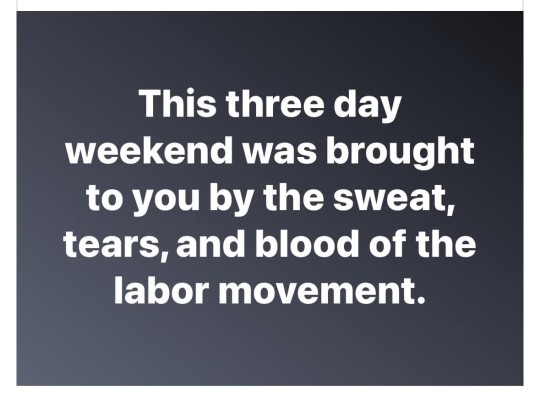
217 notes
·
View notes
Text
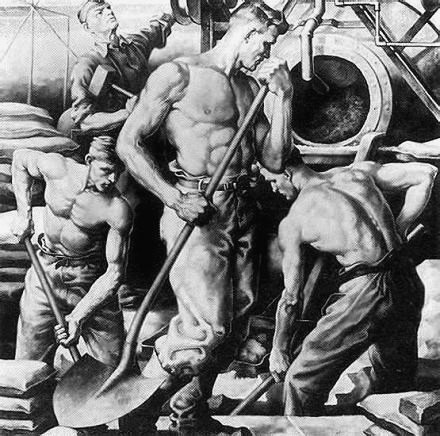
45 notes
·
View notes
Text
stop saying the clothes you made are handmade.
i will not shut up about how harmful it is to use these tiny "handmade" tags when youre a hobby tailor or a small buisness. advertising with how an item is handmade (but also just gifting people something and it has a handmade tag or button or whatever) is incredibly harmful. every piece of clothing is handmade. there might be a few exceptions but the absolute vast majority was made by hand. your primark, shein, temu and h&m clothes are handmade. these buisinesses dont want you to know that, they dont want you to see that a person made your t shirt. to think about the horrible conditions they made it in and how they are paid wages that dont allow them to live.
by putting a handmade tag on your handmade dress you are widening that gap between you, and the factory workers. you are dehumanising and devalueing them and their work.
we need everyone to understand how exactly clothing is made and who makes it. we need to understand that we are profiting off of someone elses unpaid labor. if everyone were to understand how every piece of clothing is handmade, you wouldnt need your shitty tags.
making your own clothes should teach you how much labor needs to be put into a simple pair of underwear. use that knowledge to advocate for your fellow sewists.
you can make a small lino or screen print to tag your clothes or order custom tags online! you can do that.
sewing and selling your work is great. and not underpricing it is important. so if you want to put a cute little tag on there, here are some ideas:
- made by y/n
- logo
- handmade like every piece of clothing
and for everyone who isnt a sewist/knitter/crocheter or whatever. look at each and every clothing/textile item you own or are about to buy and see how someone made it.


#sewing#sewist#tailor#textiles#clothing#handmade#fast fashion#knitting#crochet#sweatshops#overworked and underpaid#factory workers#awareness post
23 notes
·
View notes
Text

"You are not a tech bro, you are a modern day factory worker."
Oakland, California
#oakland#california#art#street art#graffiti#tech bros#modern day#factory workers#ausgov#politas#auspol#tasgov#taspol#australia#fuck neoliberals#neoliberal capitalism#anthony albanese#albanese government
12 notes
·
View notes
Text

Yuri Ivanovich Pimenov, Disabled Veterans, 1926.
Walter Benjamin on World War I: “A generation that had gone to school on a horse-drawn streetcar now stood under the open sky in a countryside in which nothing remained unchanged but the clouds, and beneath these clouds, a field of force of destructive torrents and explosions, was the tiny, fragile human body.” “This immense wooing of the cosmos was enacted for the first time on a planetary scale, that is, in the spirit of technology. But because the lust for profit of the ruling class sought satisfaction through it, technology betrayed man and turned the bridal bed into a bloodbath.”

Education of the Movements of the Wounded Soldier,” from Jules Amar, The Physiology of Industrial Organization (1918).
Henry Ford on mass production: The production of the Model T required 7,882 distinct work operations, but, Ford noted [in his 1923 autobiography], only 12% of these tasks—only 949 operations—required “strong, able-bodied, and practically physically perfect men.” Of the remainder—and this is clearly what he sees as the major achievement of his method of production— “we found that 670 could be filled by legless men, 2,637 by one-legged men, two by armless men, 715 by one-armed men and ten by blind men.” ///
Walter Benjamin’s understanding of modern experience was neurological. It centered on shock. Benjamin wanted to investigate the “fruitfulness” of Freud’s hypothesis, that consciousness parries shock by preventing it from penetrating deep enough to leave a permanent trace on memory, by applying it to “situations far removed from those which Freud had in mind." Freud was concerned with war neurosis, the trauma of “shell shock” and catastrophic accident that plagued soldiers in World War I. Benjamin claimed that this battlefield experience of shock had become “the norm” in modern life. Perceptions that once occasioned conscious reflection were now the source of shock impulses which consciousness must parry. Nowhere was this defensive reflex more apparent than in the factory, where (Benjamin cited Marx) “workers learn to coordinate their own ‘movements to the uniform and unceasing motion of an automaton.’” “Independently of the worker’s volition, the article being worked on comes within his range of action and moves away from him just as arbitrarily.” Exploitation was here to be understood as a cognitive category, not an economic one. The factory system, injuring every one of the human senses, paralyzed the imagination of the worker, whose labor was “sealed off from experience”; memory was replaced by conditioned response, learning by “drill,” skill by repetition: “practice counts for nothing.” Under conditions of modern technology, the aesthetic system undergoes a dialectical reversal. The human sensorium changes from a mode of being “in touch” with reality into a means of blocking out reality. Aesthetics—sensory perception—becomes anaesthetics, a numbing of the senses’ cognitive capacity that destroys the human organism’s power to respond politically even when self-preservation is at stake. Someone who is “past experiencing,” writes Benjamin, is “no longer capable of telling . . . proven friend . . . from mortal enemy.”
- Susan Buck-Morss, Dreamworld and Catastrophe: The Passing of Mass Utopia in East and West. Cambridge, Mass.: The MIT Press, 2000. p. 103-104
#walter benjamin#world war 1#factory workers#capitalism#soviet union#crisis of civilization#mass society#dreamworld and catastrophe#shell shock#history of trauma#academic quote#war invalids#war wounded#disability in history#reading 2024
11 notes
·
View notes
Text
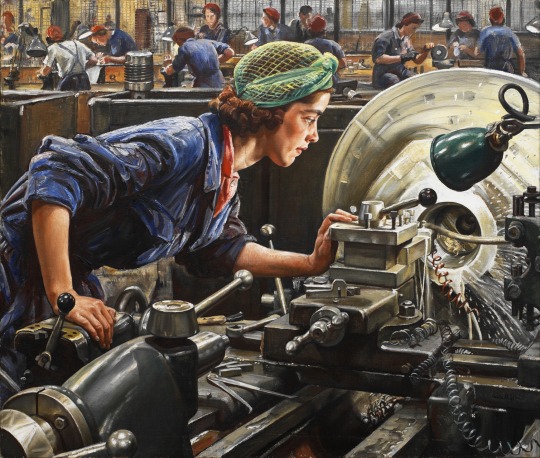
Laura Knight
Ruby Loftus screwing a Breech-ring
1943
#laura knight#wwii#wwii era#wwii england#women at work#women in war#the home front#factory workers#women artists#women painters#war documentary#british artist#british art#modern art#art history#aesthetictumblr#tumblraesthetic#tumblrpic#tumblrpictures#wwii women#aesthetic#beautiful painting#ruby loftus
130 notes
·
View notes
Text

Now I don’t go in for these American traditions (actually European) as an Australian. Bad influence on our youngsters. But being a Trade Unionist and a bit Bolshie, I couldn’t go past this.
#humour#australian#pumpkin#halloween#american culture#samhain#pagan european culture#rather teach the kids pagan european culture#have you seen american society lately#trade unionist#a worker#socialist#farmers#factory workers#covid showed who was a worker#join your union#hammer and sickle#soviet union#the cold war#my current rabbit hole
12 notes
·
View notes
Text

National Geographic, date unknown
#national geographic#womens history#wwi#world war 1#antique photo#antique photography#factory workers#1910s#magazine article#magazine clippings#my scans
4 notes
·
View notes
Text
This survey is wild! Everyone (80%) wants Americans back working in factories!
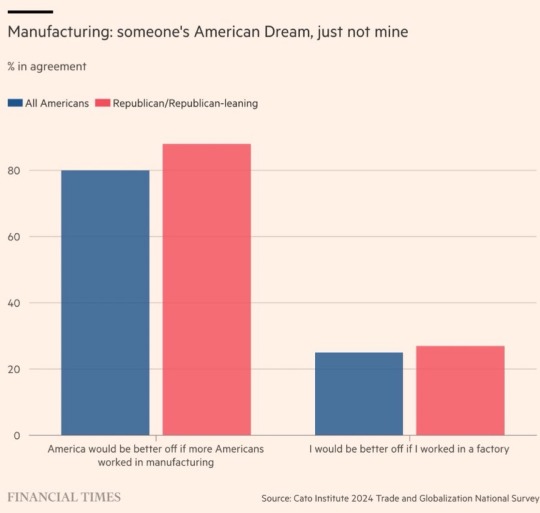
Do YOU want to work in a factory? Hell no!
Also—how many respondents actually work in factories? (2%)
Just so much dissonance?
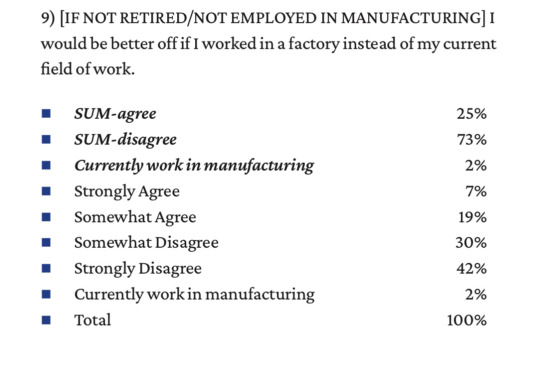

It’s always someone else’s children who have to work in the mines, isn’t it?
6 notes
·
View notes
Text
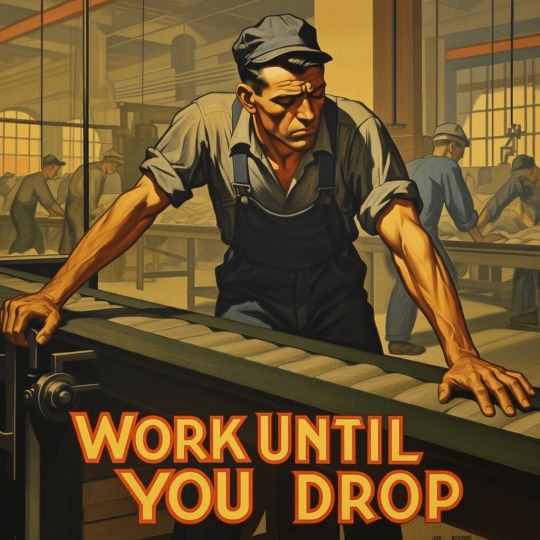
roomjosh
#work until you drop#late stage capitalism#factory workers#1940s aesthetic#propaganda poster#roomjosh#title screen#illustration#ai art#artificially generated
3 notes
·
View notes
Text

Where are Lucy and Ethel? Women at work on the assembly line at the Barton Bonbonniere factory on DeKalb Ave., Brooklyn, 1950.
Photo: Brooklyn Public Library/Urban Archive NY
#vintage New York#1950s#assembly line#factory#factory workers#Barton's candy#candy#candy factory#vintage Brooklyn#conveyer belt#laborers#women laborers
63 notes
·
View notes
Text

Hamburgs political strategy involves them haming it up with friendly nations and avoiding those they got beef with!😂
🍔🇩🇪🍔
#history#hamburger#united states#immigrants#hamburg#food history#american culture#1800s#food cart#industrial revolution#fast food#german history#american food#factory workers#street food#steak#revolutions of 1848#american history#germany#delicious#food#nickys facts
5 notes
·
View notes
Text

From the car files: illustration detail from a 1937 Packard Motor Car Company ad.
#vintage illustration#vintage advertising#packard#antique cars#the 30s#the 1930s#30s cars#1937 packard#packard cars#’37 packard#classic cars#gm#general motors#packard motor cars#packard motor car company#packard automobiles#premier luxury automobiles#luxury automobiles#factory workers#auto workers#auto industry
5 notes
·
View notes
Text
This 1943 painting by Laura Knight (1877-1970) depicts 21-year-old Ruby Loftus (2921-2004) working at an industrial lathe cutting the screw of a breech-ring for a Bofors anti-aircraft gun. Ruby became an expert in the production of breech-rings in just seven months – something that usually took years. After the war, Ruby and her husband John Green emigrated to Canada and she never worked in a factory or engineering again.

"Normal Women: 900 Years of Making History" - Philippa Gregory
#book quotes#normal women#philippa gregory#nonfiction#laura knight#ruby loftus#industrial lathe#breech ring#bofors#anti aircraft gun#expert#production#ww2#wwii#world war two#second world war#john green#emigration#canada#factory workers#engineering
17 notes
·
View notes